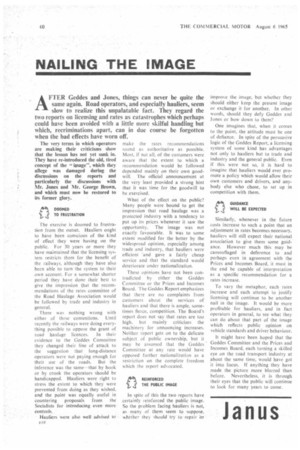NAILING THE IMAGE
Page 62

If you've noticed an error in this article please click here to report it so we can fix it.
AF I ER Geddes and Jones, Minns can never be quite the
same again. Road operators, and especially hauliers, seem slow to realize this unpalatable fact. They regard the two reports on licensing and rates as catastrophes which perhaps could have been avoided with a little more skilful handling but which, recriminations apart, can in due course be forgotten when the bad effects have worn off.
The very terms in which operators are making their criticisms show that the lesson has not yet sunk in. They have re-introduced the old, tired concept of the "image", which they allege was damaged during the discussions on the reports and particularly the discussions with Mr. Jones and Mr. George Brown, and which must now be restored to its former glory.
e2fri DOOMED
70 FRUSTRATION
The exercise is doomed to frustration from the outset. Hauliers ought to have been conscious of the kind of effect they were having on the public. For 30 years or more they have maintained that the licensing system restricts them for the benefit of the railways, although they have also been able to turn the system to their own account. For a somewhat shorter period they have done their best to give the impression that the recommendations of the rates committee of the Road Haulage Association would be followed by trade and industry in general.
There was nothing wrong with either of these contentions. Until recently the railways were doing everything possible to oppose the grant of road haulage licences. In their evidence to the Geddes Committee they changed their line of attack to the suggestion that long-distance operators were not paying enough for their use of the roads. But the inference was the same—that by hook or by crook the operators should be handicapped. Hauliers were right to stress the extent to which they were prevented from doing as they wished. and the point was equally useful in countering proposals from the Socialists for introducing even more controls.
Hauliers were also well advised to nit make the rates recommendations (limd as authoritative as possible. Most, if not all. of the customers were aware that the extent to which a recommendation would be followed depended mainly on their own goodwill. The official announcement at the very least provided a strong hint that it was time for the goodwill to be exercised.
What of the effect on the public? Many people were bound to get the impression that road haulage was a protected industry with a tendency to put up its prices whenever it saw the opportunity. The image was not exactly favourable. It was to some extent modified for the better by the widespread opinion, especially among trade and industry, that hauliers were efficient and gave a fairly cheap service and that the standard would deteriorate under nationalization.
These opinions have not been contradicted by either the Geddes Committee or the Prices and Incomes Board. The Geddes Report emphasizes that there are no complaints from customers about the services of hauliers and that there is ample, sometimes fierce. competition. The Board's report does not say that rates are too high. but mainly criticizes the machinery for announcing increases. Neither report gets on to the delicate subject of public ownership, but it may be assumed that the Geddes Committee at any rate would have opposed further nationalization as a restriction on the complete freedom which the report advocated.
riREINFORCED THE PUBLIC IMAGE In spite of this the two reports have certainly reinforced the public image. So the problem facing hauliers is not, as many of them seem to suppose, whether they should try to repair or
improve the image, but whether they should either keep the present image or exchange it for another. In other words, should they defy Geddes and Jones or bow down to them?
One imagines that, when it comes to the point, the attitude must be one of defiance. In spite of the persuasive logic of the Geddes Report, a licensing system of some kind has advantages not only to hauliers but to trade and industry and the general public. Even if this were not so, it is hard to imagine that hauliers would ever promote a policy which would allow their own customers and drivers, and anybody else who chose, to set up in competition with them.
Similarly, whenever in the future costs increase to such a point that an adjustment in rates becomes necessary, hauliers will still expect their national association to give them some guidance. However much this may be camouflaged in deference to and perhaps even in agreement with the Prices and Incomes Board, it must in the end be capable of interpretation as a specific recommendation for a rates increase.
To vary the metaphor, each rates increase and each attempt to justify licensing will continue to be another nail in the image. It would be more profitable for hauliers, and in fact operators in general, to see what they can do about that part of the image which reflects public opinion on vehicle standards and driver behaviour.
It might have been hoped that the Geddes Committee and the Prices and Incomes Board, each turning a skilled eye on the road transport industry at
about the same time, would have got . it Into focus. If anything they have made the picture more blurred than before. Nevertheless, it is through their eyes that the public will continue to look for many years to come.












































































































